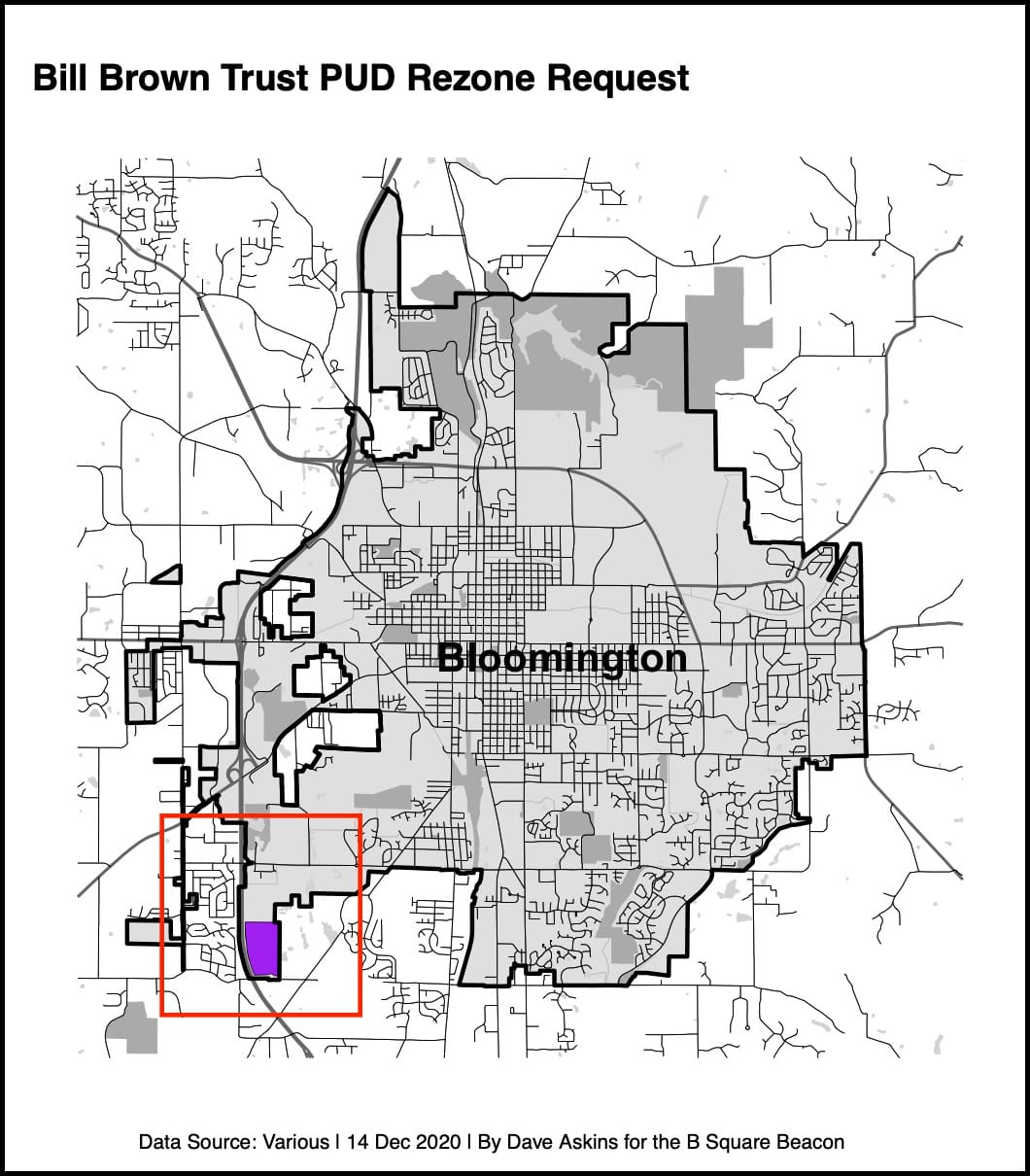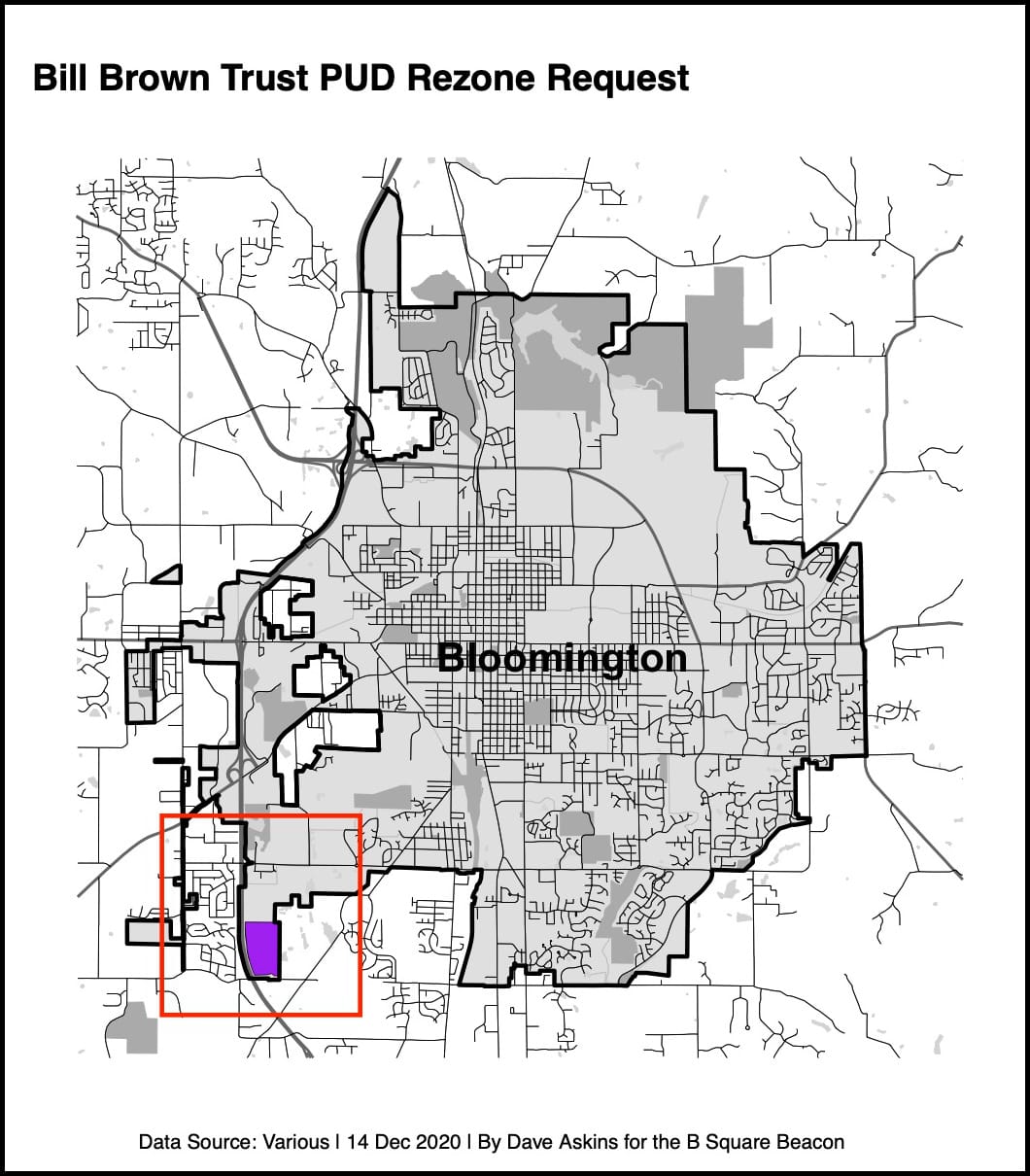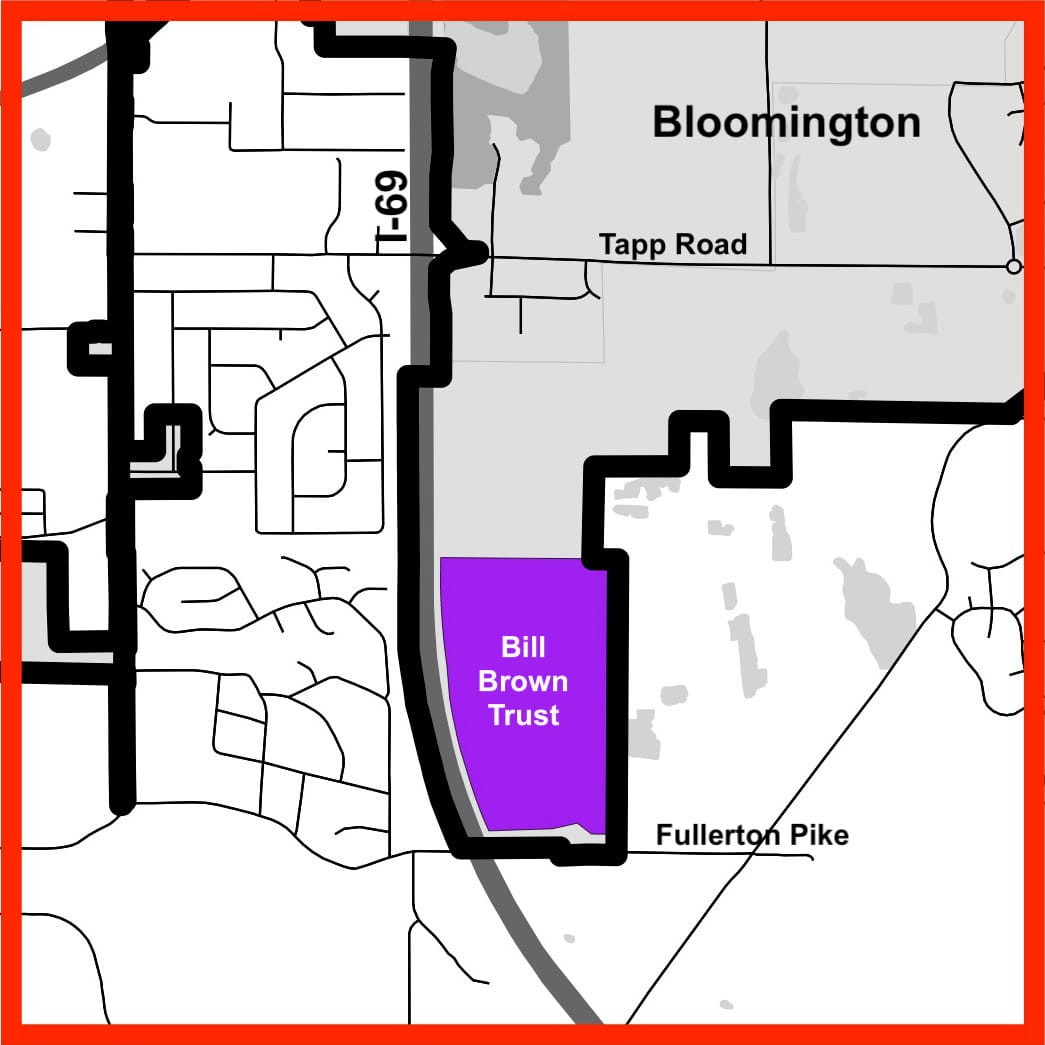87-acre parcel rezone doesn’t get hoped-for negotiation at land use committee meeting, heads to Bloomington city council with zero votes in favor




A requested rezone for 87 acres of land at the southern tip of Bloomington, next to I-69, will be considered by the city council this Wednesday (March 17).
The requested rezone is based on the idea that it will improve the marketability of the land, which has sat undeveloped under its current zoning for more than three decades.
At its meeting last Wednesday, the council’s four-member land use committee recommended against the full council’s approval of the request from owner Bill Brown, to rezone the parcel from PUD (planned unit development) to MC (mixed-use corridor).
At their meeting last week, land use committee members did not discuss the kind of zoning commitments that the plan commission had hoped the committee would negotiate. Zoning commitments are a way to constrain a zoning district to exclude certain uses.
None of the four members of the land use committee voted in favor of the rezone request.
In his presentation to the land use committee, zoning planner Eric Greulich listed out some uses that could be excluded by using zoning commitments. The uses would otherwise be permitted under MC: student housing, sexually oriented businesses, bed and breakfast, tattoo or piercing parlor, press shop, big box retail sales, transportation terminal, vehicle fleet operations (large or small).
The outcome of plan commission deliberations was a desire for the council’s land use committee to negotiate possible zoning commitments that would constrain the MC district that Brown wants.
Plan commission president Brad Wisler had said at the commission’s early-January meeting, “It’s very, very clear to me that what needs to happen here is some negotiation.”
Wisler continued, “Negotiating with a nine-member body is very, very difficult.” About the four-member group, Wisler said, “It’s less than nine—I think that will be the next-best thing.” Wisler said he wanted to “get it in the hands of the land use committee.” The message from the plan commission, Wisler said, should be “We want this to move forward, somehow.”
The vote taken by the plan commission, which was supposed to send that message, was on a motion to make a non-recommendation, which came out 6–2–1. Plan commissioner Neil Kopper dissented on the vote for a non-recommendation, because he wanted to make a recommendation for denial. Flavia Burrell dissented because she wanted to make a recommendation for approval. Israel Herrera abstained.
At their meeting, land use committee members did not take up the question of excluding the specific uses that could have been the subject of negotiation.
Committee member Steve Volan said, “Part of me is trying to fight the opinion that I just don’t care either way.”
Committee member Isabel Piedmont-Smith went as far as saying she was opposed to development at the location. “But the more I think about it,.. from its location, this is sprawl and I would actually prefer not to see development there,” Piedmont-Smith said.
Piedmont-Smith added, “Whatever we put there,…people will have to drive to get there. And it’ll probably be largely people from outside our community that use it.”
Committee member Kate Rosenbarger said, “Because I am relatively indifferent, I still just lean toward following the [comprehensive] plan.”
The city planning staff is relying on the comprehensive plan in recommending that the zoning on the 87-acre parcel be changed from PUD, as a part of the citywide zone map revision process—but not to the MC district that Brown wants.
The planning staff point to the city’s comprehensive plan as calling for the area to be developed as an employment center. So the planning staff recommendation is for a rezone to ME (mixed-use employment).
The city’s plan commission deliberated on the rezone request at meetings late last year and early this year.
Brown wants the flexibility that comes with MC zoning, to build a full-sized restaurant, which is not provided by an ME district. A sit-down restaurant is what one potential developer has indicated would be crucial to a possible development, according to Brown’s attorney, Michael Carmin.
Brown doesn’t have a specific development proposal for the property. But according to Carmin, Brown has been approached for possible development of a hotel in the southwest corner of the property, next to I-69. Brown has also been approached to develop a large part of the property as a training center for fire and emergency services.
Also a part of the mix for Brown and Carmin is the low probability they see that a large employer might develop the entire parcel as a 200-employee corporate headquarters, which would be consistent with an ME (mixed-use employment) zoning district. Instead, it would only be smaller operations—with 5, 10, 15 or maybe 30 employees—who might be interested in developing some smaller part of the 87-acres.
That’s a scenario that would require subdividing the parcel, which would trigger a requirement to build a north-south connector road, bisecting the property, according to Carmin. Greulich confirmed that subdivision would require the construction of a road.
Carmin said, “The cost estimate I have from a local engineer for the cost of that road is $2.6 million.” He added, “You cannot put in a $2.6-million road by having one user come in who’s willing to build a site of 10 to 15,000 square feet, employ 20 people—they will not pay enough for the lot.”
At the land use committee meeting, and the earlier meetings of the plan commission, Carmin has pointed out that the parcel is part of Bloomington’s consolidated TIF district, which means that in principle, public money could be used to pay for road construction. That is unlikely, Carmin has said, given that the city’s current policy has been to invest TIF revenue in more centrally-located areas—Switchyard Park, the Trades District and the 2nd Street hospital site. That means the road, which would have to be built if the property were subdivided, would have to be paid for by Brown, Carmin said.
During deliberations, land use committee member Matt Flaherty took up the question of TIF investment by drawing a parallel between the reasons that either a municipality or a private developer might invest in infrastructure improvements like road building.
Flaherty said, “We bond for that money to construct the road, with the assumption that we are going to see development that will increase our tax base and pay for that bond. And of course, that’s how TIFs are meant to work.” Flaherty added, “The same can be said for a private developer: You front the $2.6 million, with the anticipation that this will redevelop, that if you build the infrastructure, you will have more interested parties looking to develop housing or employment or various various things.”
Volan, who abstained from the committee vote, said he wanted to hear from other interested parties. He wanted to know how much money is available in the city’s TIF fund.
Early in the committee’s deliberations, Volan said the issue is not strictly one of planning and zoning, but rather includes economic development. So Volan wanted to hear an opinion from the city’s director of economic and sustainable development, Alex Crowley.
During the December plan commission meeting, Clark Greiner, who is business development director for the Bloomington Economic Development Corporation, weighed in for increased flexibility of land uses on the 87-acre site. “We support zoning flexibility,” he said, adding that the zoning flexibility should “work for the property that enables the development to benefit the community.”
At its meeting last week, the city council’s land use committee voted 0–3 on the requested rezone of the 87 acres. Those voting against the rezone were: Isabel Piedmont-Smith, Matt Flaherty, and Kate Rosenbarger.
A committee vote has no legal impact on the final outcome. Steve Volan abstained from the vote. Independent of the committee’s vote tally, the request always comes back to the full council for consideration. Committee members are not bound by their votes cast as committee members.
The city council’s information packet for the March 17 meeting is posted online.




Comments ()